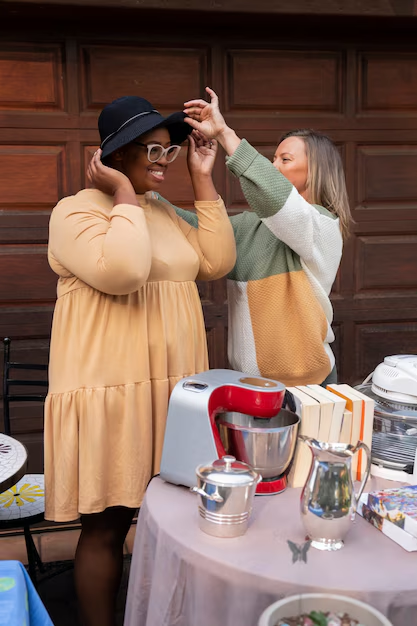Photo Credit (Pixabay)
As we age, the fear of ageing intensifies. People in their 30s examine themselves in the mirror every day to make sure they are not growing grey hair and wrinkles. The top of my head going bald is one of my worries as I get older. Another is immobility, which could hinder my ability to interact with others.
Perhaps this anxiety makes sense since we perceive ageing as a sign of degradation. We become less enjoyable as we age. We are also getting closer to death every day. We think we’re not able to enjoy old fashion. This realisation intensifies and makes us crazy.
This concern was also exacerbated by the fashion media’s ongoing idolisation of young people. Young, thin, and baby-smooth skin is commonly shown in fashion and beauty advertisements. They stand for both who we were and who we aspire to be.
However, things are changing. These days, a lot of fashion and beauty campaigns include elderly individuals. Joan Didion became Céline’s face. Iris Apfel currently works as a model for the IMG agency. Maye Musk was chosen as CoverGirl’s spokeswoman. For nearly ten years, the new representation has been in place.
Furthermore, the younger generation is also influenced by the fashion sense of the elderly, including their clothing choices and fashion philosophies. We also have an ageing population today. Maybe fashion should revitalise a timeless look that works for people of all ages. Additionally, it might ease the adjustment to old age. Marketing chances to cast senior individuals and portray the fashion of the elderly are growing.
See how this trend is applicable as a marketing tactic and what it may indicate about our contemporary culture by reading on!
Lastly, a Reasonable Marketing Strategy for a Relevant Target Audience
Our readers might have realised that elderly people are wealthy after all. The majority of elderly adults have more disposable income than younger ones due to their longer lifespans and life experiences.
This is demonstrated by the luxury fashion customer segment. Baby boomers (ages 57 to 75) and Generation X (ages 43 to 56) in the US spent five times as much on luxury brands as millennials (ages 23 to 42), per the 2016 YouGov market study. According to the report, Gen Xers and Baby Boomers spent $215 billion. Millennials, on the other hand, only spent about $49.
The fashion brand’s prior marketing strategy, which excluded elderly people from the commercial, is illogical. The elderly can genuinely afford luxury products, despite the younger generation’s fantasies about them. It makes sense that these companies plan how to connect with their customers. Increasing the number of elderly persons included in fashion ads or raising awareness of senior fashion are two examples.
Fashion and Brand Identity for the Elderly
Fashion and beauty brands are able to establish reputations since they cater to a larger demographic of older consumers. The elderly are still viewed as wise and secure despite the fear of ageing. According to the By Acre article, the identities of elderly people “reflect stories, wisdom, and confidence.” Many older fashion firms are choosing to feature more older people, perhaps because of this.
Additionally, these businesses aim to be regarded as timeless, sophisticated, and wise. They don’t want to attract young, affluent customers who spend their money impulsively. Instead, the brands aim to connect with older consumers, who naturally project an air of ease.
The Impact of Older Fashion on Young People
The role of older people in fashion extends beyond advertising campaigns. In actuality, a lot of young people enjoy admiring stylish older folks. There are ramifications for why we are so fixated on older fashion and what it may represent to the younger generation, whether it is for pure amusement or because we are genuinely inspired by what older people wear.
New Old Influencers
In 2012, the rise in popularity of social media platforms like Instagram gave many people the opportunity to become well-known influencers. The popularity of TikTok will only lead to a rise in influencers. Older folks who dress creatively become famous suddenly since anyone can be found on social media.
BaddieWinkle is one of these influencers. Baddie has more than 3.5 million Instagram followers. Baddie, who is ninety-three, is not afraid to wear brightly coloured clothing. She typically wears clothing in striking hues. Her clothes occasionally expose her skin, which is uncommon for elderly people. When she applies highly pigmented makeup, she further displays her confidence.
However, older individuals don’t have to stick out by dressing in unusual ways. They might also continue to wear the classic, easy, and adaptable styles of the past. Lyn Slater, a.k.a. Accidental Icon, is among the older influences who adhere to this aesthetic. Slater experiments with shadows. One of her ensembles consists of boot-cut trousers and a puffy top with a floral pattern. She may develop a classic style with basic yet elegant clothing.
Using Older Style on Your Moodboard
Young people’s fashions are also being influenced by older people’s styles. The Wall Street Journal highlights several Instagram accounts that feature stylish senior people on a city street, such as Chinatown Pretty and Gramparents. These two accounts have nearly 100,000 followers each. Comfortability and modest yet colourful ensembles are generally the hallmarks of elder fashion. These styles are particularly well-liked in streetwear.
Why Do We Think Older Fashionistas Are Important?
As we have already discussed, humans do naturally fear ageing. We are no longer regarded as young by the time we are thirty. Rather, we are told to give up our passion and are overburdened with obligations.
Our concern is allayed when we see elderly folks who are confident in their individuality and sense of flair. We do have a life ahead of us, as the stylish elders demonstrate. We can still be distinctive even if society tells us we are not as young as we once were. Influencers like BaddieWinkle are capable of reinventing themselves at the age of 90. These aspirations may explain why elderly people are revered on social media and featured in fashion marketing.

